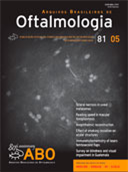Purpose: We aimed to evaluate the visual quality performance of scleral contact lenses in patients with keratoconus, pellucid marginal degeneration, and post-keratoplasty astigmatism, and their impact on quality of life.
Methods: We included 40 patients (58 eyes) with keratoconus, pellucid marginal degeneration, and post-keratoplasty astigmatism who were examined between October 2014 and June 2017 and fitted with scleral contact lenses in this study. Before fitting scleral contact lenses, we noted refraction, uncorrected distance visual acuity, spectacle-corrected distance visual acuity, uncorrected contrast sensitivity, and spectacle-corrected contrast sensitivity. We performed corneal topography on and applied a questionnaire that included the National Eye Institute Visual Functioning Questionnaire to all participants. We recorded corrected contrast sensitivity and corrected distance visual acuity on the third month after fitting scleral contact lenses and requested that subjects repeat the National Eye Institute Visual Functioning Questionnaire.
Results: The mean age of patients was 28.12 ± 13.19 years. Mean logMAR uncorrected distance visual acuity, spectacle-corrected distance visual acuity, and corrected distance visual acuity with scleral contact lenses were 0.91 ± 0.21 (0.40-1.80), 0.57 ± 0.12 (0.10-1.80), and 0.16 ± 0.02 (0.00-1.30), respectively. We observed significantly higher corrected distance visual acuity with scleral contact lenses compared with uncorrected distance visual acuity and spectacle-corrected distance visual acuity (p<0.05). Mean uncorrected contrast sensitivity, spectacle-corrected contrast sensitivity and CCS with scleral contact lenses were 0.97 ± 0.12 (0.30-1.65), 1.16 ± 0.51 (0.30-1.80), and 1.51 ± 0.25 (0.90-1.80), respectively. Significantly higher contrast sensitivity levels were recorded with scleral contact lenses compared with those recorded with uncorrected contrast sensitivity and spectacle-corrected contrast sensitivity (p<0.05). We found the National Eye Institute Visual Functioning Questionnaire overall score for patients with scleral contact lens treatment to be significantly higher compared with that for patients with uncorrected sight (p<0.05).
Conclusion: Scleral contact lenses are an effective alternative visual correction method for keratoconus, pellucid marginal degeneration, and post-keratoplasty astigmatism. A significant increase in visual acuity and contrast sensitivity can be obtained with scleral contact lenses in patients with irregular corneas.
Keywords: Keratoconus; Corneal topography; Contrast sensitivity; Sclera; Contact lenses; Sickness impact profile; Visual acuity; Quality of life
